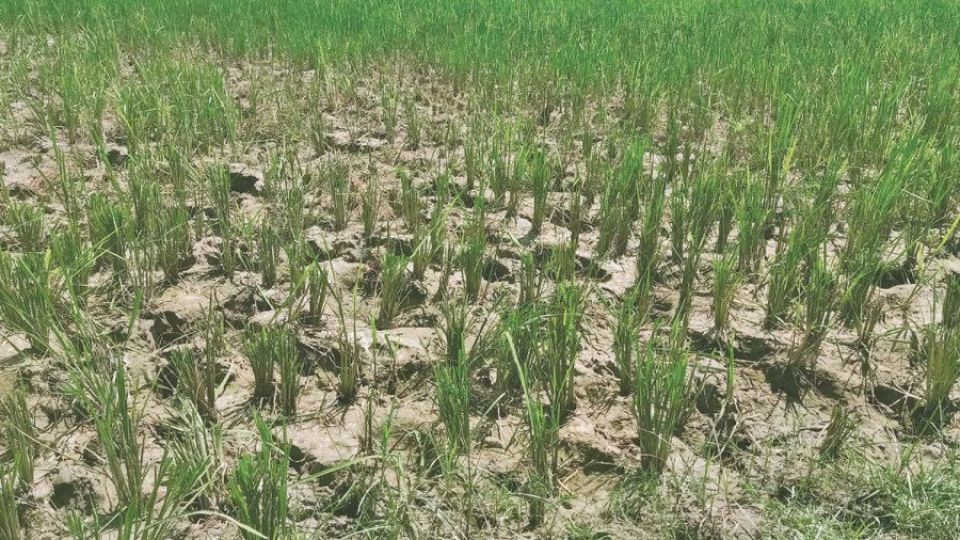September 8, 2023
KATHMANDU – Twelve years ago, Tul Bahadur Bayambu became the first farmer in his village in Palpa to grow large cardamom from saplings he had brought from Ilam.
Today, Bayambu owns a cardamom farm spread over 1.78 hectares in Nisdi Rural Municipality-3. He sells 1,000 kg of large cardamom annually.
But this season, a severe dry spell has decimated 90 percent of his crop. “Almost all my plants have died because of the drought,” he said. Farmers say there has been no rainfall for the last six months.
Farmers in the western region rely on the monsoon rains to irrigate their farmlands.
Many villages in Palpa are situated in the high altitude zone, so farmers depend on water from the sky.
“We had never faced a drought of this type in the last 12 years,” said Bayambu.
Farmers in many parts of western Nepal are having a hard time because of the drought.
Experts say that warmer, drier weather because of an earlier-than-usual El Niño is also expected to hamper rice production across Asia, hitting global food security in a world still reeling from the impacts of the war in Ukraine.
El Niño is a natural, temporary and occasional warming of part of the Pacific that shifts global weather patterns, and climate change is making them stronger.
Reports say that this year there is bad news for rice farmers, particularly in Asia where 90 percent of the world’s rice is grown and eaten since a strong El Niño typically means less rainfall for the thirsty crop.
According to the Food and Agriculture Organisation of the United Nations, agriculture is one of the main sectors of the economy that could be severely affected by the El Niño phenomenon.
While drought is the main threat to food production, El Niño can also cause heavy rains, flooding or extremely hot or cold weather.
This can lead to animal disease outbreaks, including zoonosis and food-borne diseases, as well as plant pests and forest fires.
In Palpa, Bayambu and other commercial growers face a steep drop in output because of the drought.
Around 30 families in Jhirubas Khadar are engaged in commercial cardamom farming on a combined 5 hectares, and are likely to suffer low crop yields this year.
Many farmers followed Bayambu’s lead after they saw him making four times more money from cardamom than traditional crops such as maize and broom grass. Large cardamom growers usually earn Rs500,000 a year.
As the popularity of large cardamom grew in the village, the local government, too, started providing subsidies for the saplings in 2017.
“The local government provided subsidies in several stages to attract farmers towards the cash crop,” said Dhruba Dayal, chief administration officer of Nisdi Rural Municipality.
The local farmers started sourcing the saplings from Lamjung and Ilam.
“But this year, due to the drought, the plants turned pale and dried up,” said Dayal.
Bayambu had expected to earn Rs1.5 million this year, but the drought has shattered his hopes. “I might not be able to harvest even 5 kg of large cardamom this season,” he said.
Another farmer Yam Bahadur Sunar says they have been facing troubles because they lack technical knowledge.
“There are many success stories of local growers, but they are also frequently harassed by pest infestation and other issues like drought,” said Sunar.
Nisdi Rural Municipality has declared Jhirubas Khadar as a pocket zone of cardamom production, but the local government has not been able to provide technical assistance to the farmers.
The Agriculture Knowledge Centre in Palpa also doesn’t have a dedicated technician to educate the farmers about the issues.
Nabindra Thapa, chief of Nisdi Rural Municipality-3, says the local government has been discussing providing a relief package to drought-stricken large cardamom growers.
Kailali and Kanchanpur districts in western Nepal too have not received rainfall since mid-August.
Due to the prolonged drought, the paddy fields have turned yellowish.
“There was a drizzle on August 26,” said Singal Chaudhary, assistant meteorologist of the Department of Hydrology and Meteorology in Attariya. “The temperature is increasing each successive day due to the drought.”
Chaudhary added that there was no possibility of rain in the region for another week.
Hari Datta Joshi, chief of the Agriculture Knowledge Centre in Kanchanpur, said that the crops, mainly paddy, had started to dry in the farmers’ fields.
“Several pests and diseases have started to appear due to the drought,” said Joshi.
Pests like Borer and Brown Planthoppers have been infesting the paddy fields.
The farmers are using canals and deep borings to irrigate their fields in some areas. But in most places where farmers rely solely on rain, there is no alternative.
Joshi said that 10 to 15 farmers visit the Agriculture Knowledge Centre each day along with their pest-infested paddy plants to seek solutions.
“Paddy plants need ample water at the seed-bearing stage, but the fields are dry,” he said. “If there is no rain within a week, the farmers are in deep trouble.”
The monsoon arrived in Sudurpashchim province later than usual this year.
In the past, the monsoon used to enter the region on June 10, but this year, it started on June 24.
Due to the delayed rains, farmers also transplanted their paddy later than usual.
Agriculture experts say that paddy production in the district will fall significantly this year due to the damage caused by the drought.
Nepal’s southern neighbour India has banned exports of rice, wheat and sugar, expecting arid El Niño conditions.


